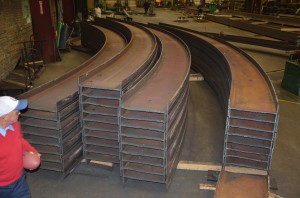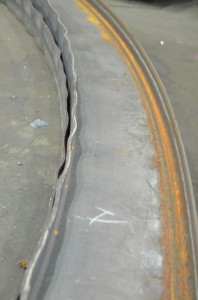In my two previous blogs, I discussed the curving of “big beams” (wide flange sections) curved or bent the hard way (x-x or strong axis). Upon reviewing those blogs, I realized that it might have been helpful to start with a few hard way beam bending or curving basics. Thus, the title, Hard Way Beam Bending 101.
There are three important factors in determining the tightest of “minimum” radius to which a wide flange section can be curved or bend the hard way. The first, and I would think most obvious factor, would be the depth of the wide flange section. A basic understanding of structural principles would dictate that a W12x35 could be curved or bent to a much tighter radius that a W18x46, W24x62, W30x99 or a W36x135. As an example, we have curved a W12x35 to an 11 foot 9 inch inside radius (IR), W18x46 to a 15ft 2in IR, W24x62 to a 28ft 6in IR, W30x116 to a 58ft 6in IR and a W36x182 to a 92ft 10in IR. For a list of produced wide flange sections and producing steel mills, visit the AISC website (https://www.aisc.org) or the website of most any steel warehouse.
The second factor in determining the tightest possible radius for curving or bending a wide flange section the hard way is the web thickness. The radius to which a W12x14 (22ft 6in IR) can be curved to, is not the same as a W12x22 (11ft 6in IR). Both beams are in the same “family” (similar depth and flange width), but the W12x14 has a web thickness of 0.200 inches, while the W12x22 has a web thickness of 0.260 inches. The additional web thickness of 0.060 inches allows the bender/roller to curve a W12 in the same family to a radius that is 11ft 0in tighter than the other. This is a substantial difference.

The third factor is the width of the flanges (and the flange thickness). Flange width is a factor in that the bottom or inside flange has a tendency to ripple or wave the greater the width of the flange and the tighter the curve radius. The ripple or wave can be minimized by increasing the flange thickness, usually by using a member in the same family. Another possibility would be to increase the depth of the wide flange section, but decrease the width of the flanges.

To summarize, beam depth, web thickness, and flange width (and thickness) are the most important factors in determining the “minimum” or “tightest” radius to which a wide flange section can be curved the hard way. It is always recommended that one (architect, engineer, structural steel fabricator, etc.) contact a bender/roller in regards to the “minimum radius” to which a wide flange section can be curved or bent the hard way. Most bender/rollers have years of records and notes regarding what wide flange sections can be curved or bent to a specified radius. The wise choice is to know what radius can be achieved prior to designing or detailing a specific wide flange section to a specific radius.







